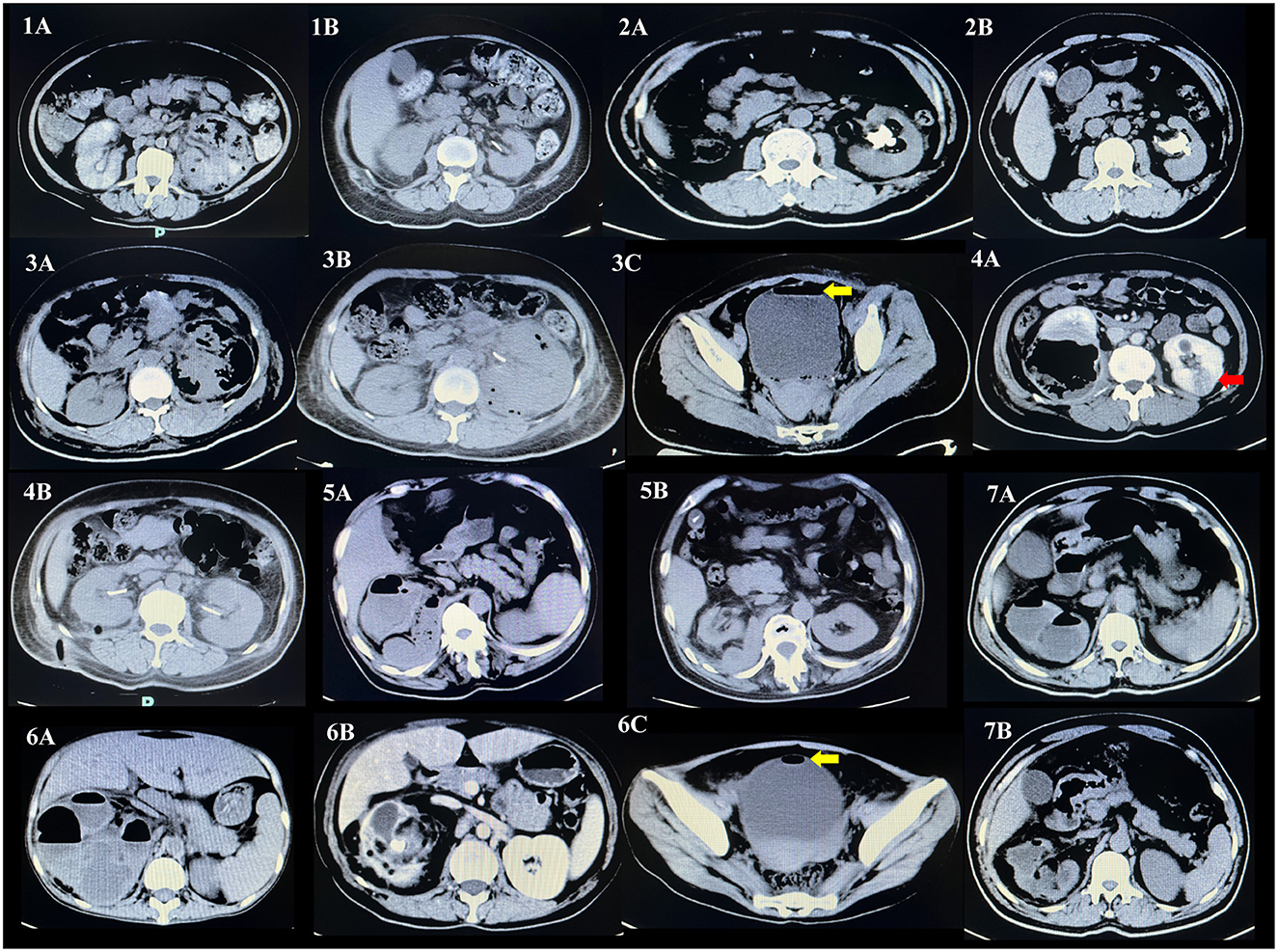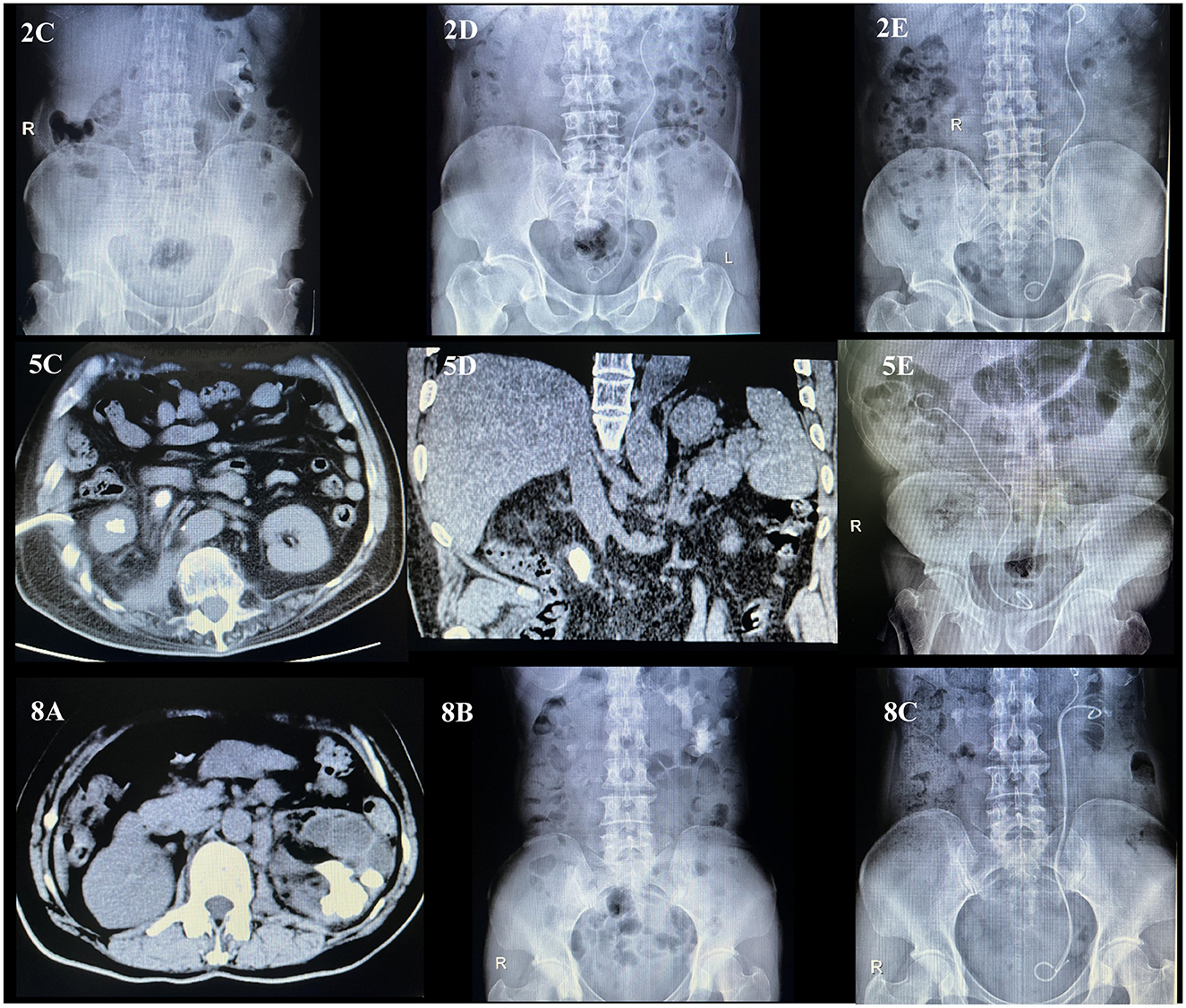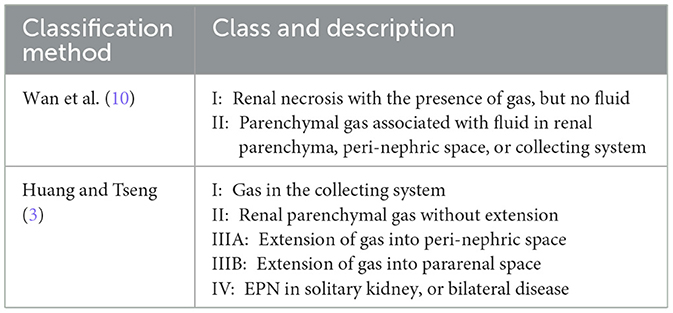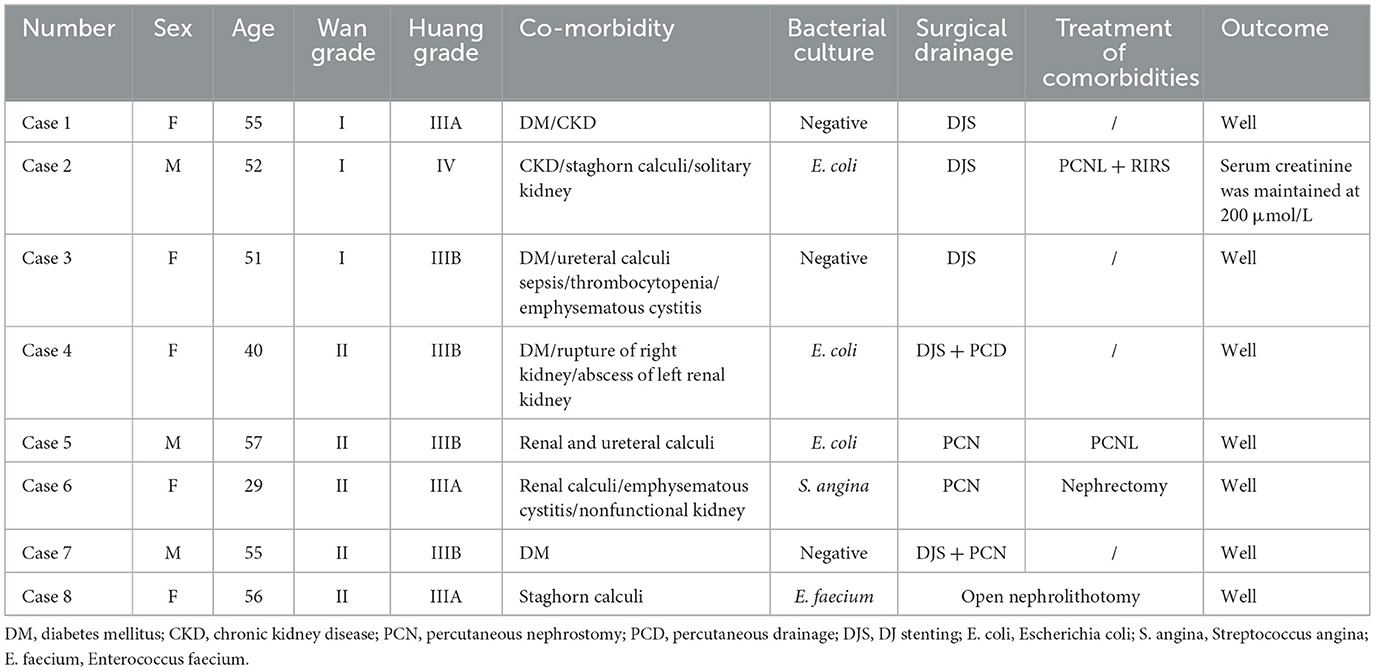- 1Department of Urology, Affiliated Hospital of Zunyi Medical University, Zunyi, Guizhou, China
- 2Department of Invasive Technology, Affiliated Qingyuan Hospital (Qingyuan People's Hospital), Guangzhou Medical University, Qingyuan, Guangdong, China
- 3Department of Urology, Xinyang 154 Hospital, Xinyang, Henan, China
- 4Department of Urology, People's Hospital of Wuchuan, Zunyi, Guizhou, China
Objective: This study aims to discuss and summarize the diagnosis and treatment of emphysematous pyelonephritis (EPN).
Methods: Retrospective medical records review of all patients diagnosed with EPN from January 2017 to June 2023 in our hospital were analyzed. A total of eight patients (three males and five females) were enrolled. The mean age was 49.38 ± 3.48 years. Among them, one case was complicated by sepsis, two by emphysematous cystitis, two by chronic renal failure, four by diabetes, and five by urolithiasis. Upon admission, all patients received aggressive antimicrobial therapy. Surgical interventions consisted of drainage procedures tailored to each patient's specific condition along with management for upper urinary tract calculi present. Clinical data were analyzed in depth and compared with the previously published studies.
Results: All patients complied with the protocol of catheter removal as scheduled and were discharged after complete recovery. No recurrence of infection was recorded during the follow-up.
Conclusions: Most EPN patients suffer from severe and complex medical conditions. Selecting an appropriate surgical drainage strategy can significantly reduce the rates of infection recurrence, nephrectomy and mortality, thereby improving the patient's prognosis.
Introduction
In clinical practice, EPN is a rare event and characterized by acute necrotizing inflammation of the renal pelvis, parenchyma and surrounding tissues caused by gas-producing pathogens (1). Generally, EPN could progress rapidly and carry a high mortality rate of up to 43% if the patient has not received a timely intervention (2). Recent studies indicated lower mortality rates ranging from 0% to 37.5%, primarily attributed to advancements in sensitive antibiotic therapies and aggressive surgical approaches. Unfortunately, its rates of nephrectomy and recurrent infection remain significantly high, up to 1.4%−37.5% and 0%−28.6%, respectively (3–9). The prognosis may be influenced by the timing and efficacy of surgical treatment strategies. Hence, for those EPN patients with varying degrees of complexity, it is necessary to adopt an individualized and precise surgical approach. This can ensure adequate surgical drainage and effective management of complications, thereby significantly improving the prognosis. Here, we have retrospectively analyzed the therapeutic regimens and prognoses of eight patients with EPN in our hospital in recent years. The aim of this study is to elaborate on the diagnostic and therapeutic approaches in EPN.
Materials and methods
A retrospective analysis was conducted on the medical records of eight patients diagnosed with EPN who were admitted to our hospital from February 2017 to June 2023. Among them, there were three males and five females, with a mean age of (49.38 ± 3.48) years. The lesions involved the left kidney in four cases and the right kidney in four cases. Comorbidities included diabetes in four cases, urolithiasis in five cases, chronic renal failure in two cases, septicemia in one cases and emphysematous cystitis in two cases. All patients exhibited symptoms of lumbalgia and fever, prompting abdominal computed tomography (CT) scans for confirmation of EPN diagnosis. Besides, their blood routine examinations revealed a total leukocyte count of (10.05 ± 2.62) × 109/L, neutrophil percentage of (0.77 ± 0.03)%, platelet count of (327.9 ± 71.96) × 109/L, hs-CRP of 131 ± 21.23 mg/L, hemoglobin of 95.88 ± 10.93 g/L, prealbumin of 89.75 ± 18.30 mg/L, and albumin of 27.01 ± 1.68 g/L {the classification method for EPN is presented in Table 1 [Wan. et al. (10) and Huang and Tseng (3)], and the general information of the patients is shown in Table 2}.
Upon admission, all patients received broad-spectrum antibiotics for anti-infection treatment, such as piperacillin-tazobactam or imipenem-cilastatin. For patients with concurrent diabetes, controlled blood glucose was required. After comprehensive treatment, all patients improved their symptoms and were successfully discharged. During follow-up, they were in good condition and had no relapse (the specific treatment plan is shown in Table 2, the comparison of preoperative and postoperative effects is shown in Figure 1, and the comparison of fragmentation effects before and after is shown in Figure 2).

Figure 1. Comparative imaging data before and after operation of patient 1–7. Preoperative CT scan results: (1A−7A). Recheck CT scan results 1 week after operation: (1B−7B). Complicated with emphysematous cystitis: (3C, 6C). The yellow arrow indicates emphysematous cystitis. Complicated with left kidney abscess: (4A). The red arrow points to a renal abscess.

Figure 2. Comparative imaging data before and after operation of patient 2, 5, and 8. Preoperative CT scan results: (2C, 5C, 5D, 8A, 8B). The stone-free rates after twice operation: (2D, 2E). The stone-free rates after primary operation: (5E, 8C).
Discussion
EPN is a relatively rare and serious infectious disease in urology, and its combination with emphysematous cystitis is even rarer (11). Its pathogenesis involves gas-producing pathogens reproduce in the renal pelvis, parenchyma, and surrounding tissue spaces, which leads to the continuous accumulation of gas and causes severe necrotizing infection. Clinically, it is more likely to occur in adult women (the ratio of men to women is 1:4 to 1:6), and there are very few reports in children (12). Risk factors contributing to its progressive disease include diabetes (up to 95%), female gender, urinary tract obstruction, and compromised immunity (1). The main pathogens associated with EPN are G– bacteria, with Escherichia coli being the most common isolate, followed by Klebsiella species and Proteus mirabilis. There have also been instances involving Candida and Mucormycosis pathogenicity (13–15). The microbiological characteristics of this group are basically consistent with the literature reports, with bacterial cultures of blood/urine showing. The clinical manifestations and laboratory tests in cases of EPN lack significant specificity. Consequently, its diagnosis, assessment of severity and prognosis should largely depend on CT examinations (15). With advancements in ultrasound technology, point-of-care ultrasound (POCUS) plays a critical role in rapid clinical decision-making within EPN, particularly benefiting critically ill, irremovable patients (16, 17). Remarkably, only highly sensitive C-reactive protein increased significantly on admission in our cases. In addition, one patient had a comorbid sepsis with thrombocytopenia, which led to a prolonged hospital stay.
The routine treatment of EPN is based on controlling diabetes and using sensitive antibiotics. In our study cohort, empirically selected broad spectrum antibiotics, such as piperacillin tazobactam, showed relative sensitivity to G– bacteria and covered some G+ bacteria as well. Imipenem-cilastatin was used for patients with multiple risk factors (18, 19), including advanced age, bilateral kidney involvement, shock, thrombocytopenia, and medical treatment alone. Our experience with antibiotic selection is also consistent with the study by Kai et al. (20), who concluded that antibiotics should be selected clinically in a stratified manner according to disease severity.
In the past, emergency nephrectomy was the preferred surgical treatment for EPN. By the 1980s, percutaneous nephrostomy (PCN) had begun to be used in the treatment of EPN and was widely accepted (21). Emergency nephrectomy had become the last option for serious EPN patients, and early surgical drainage could significantly reduce its rates of mortality and nephrectomy (20, 22). Currently, three surgical drainage methods are widely recognized, namely double-J stent placement (DJS), percutaneous drainage (PCD), and PCN. Nevertheless, there is still no consensus on which method is superior or should be given priority as the first option. Some researchers regarded DJS as the first option because of its good efficacy, and other advantages like lower procedural complexity, less trauma, easier care, etc. (23). Conversely, Newcomer et al. recommend PCN/PCD as the initial surgical drainage strategy (5–8). Based on our findings, the differences in these studies can be attributed to the unique advantages and disadvantages of each drainage method. Therefore, the selection of the most appropriate method should be based on the patient's specific clinical situation. For example, in Das's study, patients with type I/II underwent DJS, those with type III/IV underwent PCN, and only one patient with ureteral stones underwent open ureterolithotomy after undergoing DJS. Regardless of EPN classification, Newcomer et al. choose PCN/PCD/DJS. Therefore, different surgical drainage procedures should be selected according to patients' condition. Alternatively, combined procedures can be adopted to fully decompress and drain the infected lesions, which is more conducive to infection control. Compared with Deoraj et al. (24) who proposed choosing a treatment plan based on the classification of EPN, individualized drainage should also fully consider the patient's pathogenic factors, imaging features, and complications.
In patients with EPN, sufficient surgical drainage and rational antibiotic treatment can steadily control the infection. On this basis, effective management of complications can further improve the prognosis (25). While all patients in this study demonstrated relatively favorable outcomes, the potential for reporting bias remains given the limited sample size of this retrospective analysis. The following surgical cases are summarized to compare the advantages and disadvantages of each drainage method in different patients: ① The option of appropriate surgical drainage should be based on a comprehensive assessment of the patient's imaging findings and condition, so as to best reduce intrarenal pressure and ensure complete drainage of the infected pus. For example, in cases 1 and 3, despite the infection extending to the renal capsule or perirenal space, there was minimal gas and fluid accumulation, and no significant dilatation of the collecting system was observed. Given the presence of large amounts of gas and fluid, precise PCN puncture is challenging, and PCD also has poor drainage efficacy on separating abscess cavities. Thus, only DJS seems to be more suitable. In case 4, a single abscess due to infection unconnected to the renal pelvis required DJS in addition to PCD to relieve pressure in the renal pelvis. In some cases, like case 7, EPN patients might not get the expected results despite receiving internal drainage. At this point, an additional external drainage such as PCN is especially crucial. The poor outcome of internal drainage could be attributed to narrowing of the renal calyx neck. Therefore, those patients should choose internal and external combined drainage to achieve sufficient decompression and drainage. ② Currently, there is no consensus regarding optimal timing for surgical intervention when managing kidney stones. In this cohort, case 3 with upper urinary tract calculi and case 2 with a renal cast stone in a solitary kidney underwent staged stone removal procedures. After the first procedure combining percutaneous nephrolithotomy and lithotripsy (PCNL) with retrograde intrarenal surgery (RIRS) in case 2, the patient experienced a mild fever (38.5°C). With the infection under control, the patient underwent further RIRS to remove the ureteral stone and recovered well. Case 5 remained stable after the second stage of stone removal. Therefore, it is generally safer to perform intracavitary stone removal surgery in stages. It is also important to monitor surgical duration and maintain low-pressure irrigation. Open surgery is another relatively safe option for stone extraction that can be attempted as a one-stage procedure. In case 8 with complete staghorn calculus, one-stage open nephrolithotomy offers a reliable and safe approach for decompression, drainage, and stone clearance. It not only permits sufficient drainage of intrarenal pus and reduces the spread of infection, but also makes it possible to completely remove stones in a single procedure. Additionally, postoperative complications such as urine leakage, urinary fistula, and recurrent infections were avoided, thus sparing patients the psychological and financial burdens of multiple surgeries.
With a sample size of only eight cases (n = 8), it is difficult to draw generalizable conclusions. EPN is usually a complex and severe event, with considerable variation in clinical presentation across different patients. Treatment strategies for EPN should be tailored to the individual patient's condition, involving a comprehensive evaluation followed by prompt decompression and drainage. Effectively managing any comorbidities is also essential. This approach contributes to reduced infection relapse, decreased nephrectomy requirements, and lower mortality in patients.
Data availability statement
The original contributions presented in the study are included in the article/supplementary material, further inquiries can be directed to the corresponding author.
Ethics statement
The studies involving humans were approved by Ethical Committee of Biomedical Research, Affiliated Hospital of Zunyi Medical University. The studies were conducted in accordance with the local legislation and institutional requirements. The participants provided their written informed consent to participate in this study. Written informed consent was obtained from the individual(s) for the publication of any potentially identifiable images or data included in this article.
Author contributions
DJ: Data curation, Investigation, Methodology, Writing – original draft, Writing – review & editing. YT: Data curation, Investigation, Methodology, Writing – review & editing. WT: Writing – review & editing. PX: Data curation, Writing – review & editing. GC: Data curation, Writing – review & editing. LG: Writing – review & editing.
Funding
The author(s) declare that no financial support was received for the research and/or publication of this article.
Conflict of interest
The authors declare that the research was conducted in the absence of any commercial or financial relationships that could be construed as a potential conflict of interest.
Generative AI statement
The author(s) declare that no Gen AI was used in the creation of this manuscript.
Publisher's note
All claims expressed in this article are solely those of the authors and do not necessarily represent those of their affiliated organizations, or those of the publisher, the editors and the reviewers. Any product that may be evaluated in this article, or claim that may be made by its manufacturer, is not guaranteed or endorsed by the publisher.
References
1. Sherchan R, Hamill R. Emphysematous Pyelonephritis. Treasure Island, FL: StatPearls Publishing (2025).
2. Misgar RA, Mubarik I, Wani AI, Bashir MI, Ramzan M, Laway BA. Emphysematous pyelonephritis: a 10-year experience with 26 cases. Indian J Endocrinol Metab. (2016) 20:475–80. doi: 10.4103/2230-8210.183475
3. Huang JJ, Tseng CC. Emphysematous pyelonephritis: clinicoradiological classification, management, prognosis, and pathogenesis. Arch Intern Med. (2000) 160:797–805. doi: 10.1001/archinte.160.6.797
4. Narlawar RS, Raut AA, Nagar A, Hira P, Hanchate V, Asrani A. Imaging features and guided drainage in emphysematous pyelonephritis: a study of 11 cases. Clin Radiol. (2004) 59:192–7. doi: 10.1016/S0009-9260(03)00295-2
5. Kangjam SM, Irom KS, Khumallambam IS, Sinam RS. Role of conservative management in emphysematous pyelonephritis - a retrospective study. J Clin Diagn Res. (2015) 9:Pc09–11. doi: 10.7860/JCDR/2015/16763.6795
6. Sokhal AK, Kumar M, Purkait B, Jhanwar A, Singh K, Bansal A, et al. Emphysematous pyelonephritis: changing trend of clinical spectrum, pathogenesis, management and outcome. Turk J Urol. (2017) 43:202–9. doi: 10.5152/tud.2016.14227
7. Puvvada S, Arjun N, Mylarappa P, Gowda RD. A prospective analysis of emphysematous pyelonephritis at a tertiary care centre. J Clin Urol. (2018) 11:398–402. doi: 10.1177/2051415817752854
8. Newcomer JB, Myers CB, Chacon E, Kim JK, Raissi D. Percutaneous drainage for non-operative management of emphysematous pyelonephritis: clinical characteristics and predictors of success. J Clin Imaging Sci. (2022) 15:59. doi: 10.25259/JCIS_103_2022
9. Al-Saraf M, Al-Busaidy S, George K, Elawdy M, Al Hajriy MNM, Al-Salmi I. Emphysematous pyelonephritis disparities observed in the use of percutaneous drainage techniques. Sultan Qaboos Univ Med J. (2022) 22:113–6. doi: 10.18295/squmj.4.2021.058
10. Wan YL, Lee TY, Bullard MJ, Tsai CC. Acute gas-producing bacterial renal infection: correlation between imaging findings and clinical outcome. Radiology. (1996) 198:433–8. doi: 10.1148/radiology.198.2.8596845
11. Hudnall MT, Jordan BJ, Horowitz J, Kielb S. A case of emphysematous cystitis and bladder rupture. Urol Case Rep. (2019) 24:100860. doi: 10.1016/j.eucr.2019.100860
12. Girgenti V, Pelizzo G, Amoroso S, Rosone G, Di Mitri M, Milazzo M, et al. Emphysematous pyelonephritis following ureterovesical reimplantation for congenital obstructive megaureter. Pediatric case report and review of the literature. Front Pediatr. (2019) 7:2. doi: 10.3389/fped.2019.00002
13. Mabadi A, Davoudi-Monfared E, Jafarieh A, Nazemi P. Emphysematous pyelonephritis due to Candida albicans in a diabetic patient: a case report. Urol Case Rep. (2025) 59:102960. doi: 10.1016/j.eucr.2025.102960
14. Sriram S, Shakthivel V, Jayaprada R, Chandana Sree M, Reddy KVK, Ram R. Emphysematous pyelonephritis due to mucormycosis. Trop Doct. (2025) 494755251332993. doi: 10.1177/00494755251332993
15. Schutz EA, Zabott AP, Boaretto RBB, Toyama G, Morais CF, Moroni JG, et al. Emphysematous pyelonephritis caused by C. glabrata. J Bras Nefrol. (2021) 44:447–51. doi: 10.1590/2175-8239-jbn-2020-0184
16. Salgado OJ, Vidal AM, Koratala A, Salazar-Torres ZK, Espinosa HM. Timely diagnosis of emphysematous pyelitis by point-of-care ultrasound in an outpatient setting prevented infection spread: a case report and review of the literature. J Med Case Rep. (2025) 19:319. doi: 10.1186/s13256-025-05361-5
17. Villanueva JC, Huarhua AF, Cardenas MC, Lazarus NL, Dreyfuss A, Martin DA. Ultrasound findings of emphysematous pyelonephritis: a case series. J Am Coll Emerg Physicians Open. (2025) 6:100190. doi: 10.1016/j.acepjo.2025.100190
18. Ngo XT, Vu DH, Thai MS, Hoang KC, Thai KL, Duong NX, et al. Identifying predictors of in-hospital mortality in patients with emphysematous pyelonephritis: insights from a large retrospective cohort. World J Urol. (2025) 43:347. doi: 10.1007/s00345-025-05696-0
19. Ngo XT, Nguyen TT, Dobbs RW, Thai MS, Vu DH, Dinh LQV, et al. Prevalence and risk factors of mortality in emphysematous pyelonephritis patients: a meta-analysis. World J Surg. (2022) 46:2377–88. doi: 10.1007/s00268-022-06647-1
20. Kai M, Bo Y, Xingke Q, Qingquan X, Liulin X, Xiongjun Y, et al. Upper urinary traet caleuli complicating with emphysematous pyelonephritis: 5 cases report and literature review. Chin J Urol. (2020) 41:277–81. doi: 10.3760/cma.j.cn112330-20200203-00055
21. Hudson MA, Weyman PJ, van der Vliet AH, Catalona WJ. Emphysematous pyelonephritis: successful management by percutaneous drainage. J Urol. (1986) 136:884–6. doi: 10.1016/S0022-5347(17)45115-9
22. Adapala RR, Shetty R, Venugopal P, Prabhu GGL, Yalla D, Unnikrishnan B. Renal salvage, an achievable goal in patients with emphysematous pyelonephritis: outcomes of an algorithmic renal preserving strategy. Urol Ann. (2020) 12:156–62. doi: 10.4103/UA.UA_67_19
23. Das D, Pal DK. Double J stenting: a rewarding option in the management of emphysematous pyelonephritis. Urol Ann. (2016) 8:261–4. doi: 10.4103/0974-7796.184881
24. Deoraj S, Zakharious F, Nasim A, Missouris C. Emphysematous pyelonephritis: outcomes of conservative management and literature review. BMJ Case Rep. (2018). doi: 10.1136/bcr-2018-225931
Keywords: emphysematous pyelonephritis, individualized surgical treatment, surgical drainage, treatment of comorbidities, prognosis
Citation: Jiang D, Taoyu Y, Tao W, Xianyue P, Chenren G and Guobiao L (2025) Emphysematous pyelonephritis: eight case reports and literature review. Front. Med. 12:1570638. doi: 10.3389/fmed.2025.1570638
Received: 04 February 2025; Accepted: 22 July 2025;
Published: 03 September 2025.
Edited by:
Devajit Chowlek Shyam, Aster DM Healthcare, United Arab EmiratesReviewed by:
Jad A. Degheili, Ibn Sina Hospital, KuwaitAhmet Emin Dogan, Dışkapı Yildirim Training and Research Hospital, Türkiye
Copyright © 2025 Jiang, Taoyu, Tao, Xianyue, Chenren and Guobiao. This is an open-access article distributed under the terms of the Creative Commons Attribution License (CC BY). The use, distribution or reproduction in other forums is permitted, provided the original author(s) and the copyright owner(s) are credited and that the original publication in this journal is cited, in accordance with accepted academic practice. No use, distribution or reproduction is permitted which does not comply with these terms.
*Correspondence: Liang Guobiao, bGdiMTExMUAxMjYuY29t
†These authors share first authorship
 Du Jiang
Du Jiang Yang Taoyu2†
Yang Taoyu2† Wu Tao
Wu Tao
